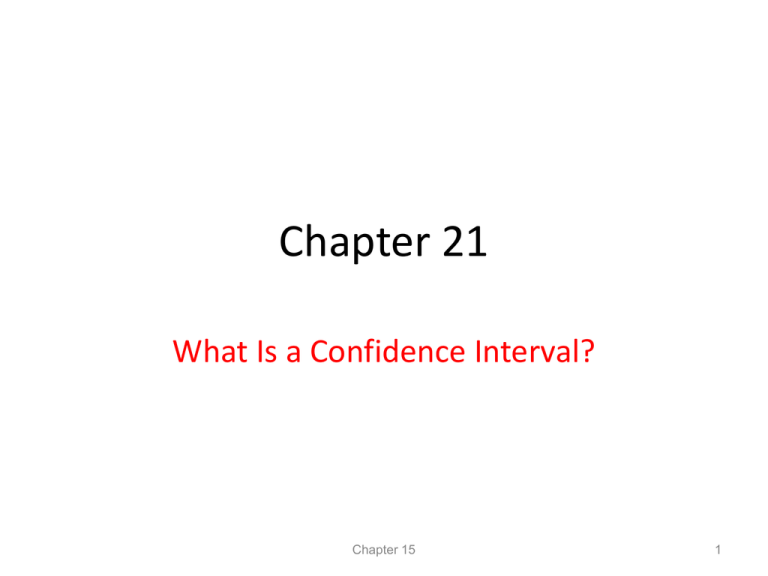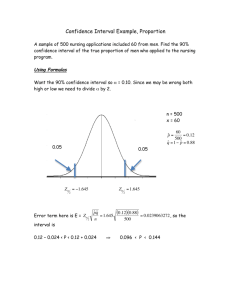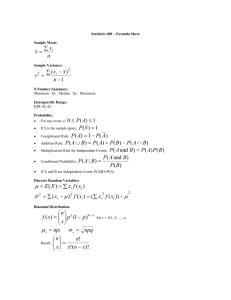ppt
advertisement

Chapter 21 What Is a Confidence Interval? Chapter 15 1 Recall from previous chapters: Parameter fixed, unknown number that describes the population Statistic known value calculated from a sample a statistic is used to estimate a parameter Sampling Variability different samples from the same population may yield different values of the sample statistic estimates from samples will be closer to the true values in the population if the samples are larger. Chapter 21 2 The Rule for Sample Proportions Chapter 21 3 Rule Conditions and Illustration For rule to be valid, must have 1. Random sample 2. ‘Large’ sample size Chapter 21 4 Case Study: Fingerprints A Question Assume that the proportion of all men who have leftward asymmetry is 15%. Is it unusual to observe a sample of 66 men with a sample proportion (p̂) of 30% if the true population proportion (p) is 15%? Chapter 21 5 Case Study: Fingerprints Answer to Question Where should about 95% of the sample proportions lie? mean plus or minus two standard deviations 0.15 2(0.044) = 0.062 0.15 + 2(0.044) = 0.238 95% should fall between 0.062 & 0.238 Chapter 21 6 Formula for a 95% Confidence Interval • sample proportion plus or minus two standard deviations of p(1 p) the sample proportion: p 2 n Chapter 21 7 Formula for a 95% Confidence Interval pˆ (1 pˆ ) pˆ 2 n standard error (estimated standard deviation of p̂ ) Chapter 21 8 Margin of Error pˆ (1 pˆ ) 2 (plus or minus part of C.I.) n 2 0.5(1 0.5) n Chapter 21 1 n 9 Formula for a C-level (%) Confidence Interval for the Population Proportion pˆ (1 pˆ ) pˆ z * n where z* is the critical value of the standard normal distribution for confidence level C Chapter 21 10 Common Values of z* Confidence Level C Critical Value z* 50% 0.67 60% 0.84 68% 1 70% 1.04 80% 1.28 90% 1.64 95% 1.96 (or 2) 99% 2.58 99.7% 3 99.9% 3.29 Chapter 21 11 Gambling on Sports A December 2007 Gallup Poll con-sisting of a random sample of 1027 adult Americans found that 17% had gambled on sports in the last 12 months. Find a 95% confidence interv for the proportion of all adult Americans who gambled on sports in this time period. How would you interpret this interval? Chapter 21 12 A 99% confidence interval The BRFSS random sample of 2166 college graduates in California in 2006 found that 279 had engaged in binge drinking in the past year. We want a 99% confidence interval for the proportion p of all college graduates in California who engaged in binge drinking in the past year. Chapter 15 13 Our statistical software has a “random number generator” that is supposed to produce numbers scattered at random between 0 to 1. If this is true, the numbers generated come from a population with μ = 0.5. A command to generate 100 random numbers gives outcomes with mean x = 0.536 and s = 0.312. Give a 90% confidence interval for the mean of all numbers produced by the software. Chapter 15 14 We would like to estimate the mean GPA of the population of all WSU undergraduates. We would like to compute a 90 percent confidence interval for this mean, and we would like our interval to have margin of error no greater than 0.1. The Registrar's Office says that a reliable guess of the population standard deviation is 0.5. What is the smallest number of students we should recruit to achieve our goals? Chapter 15 15








